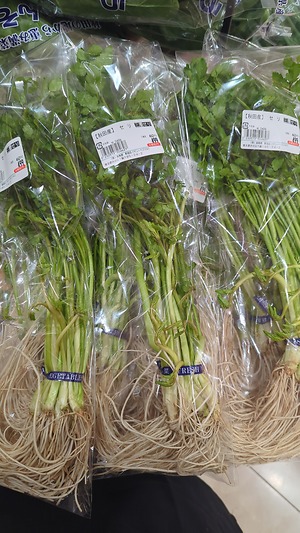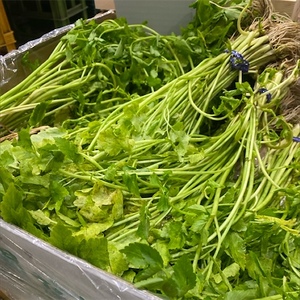


Seri (Japanese Parsley)
Estimated Inventory, lb : 0
Description/Taste
Seri is comprised of slender, upright stems topped with small, serrated leaves growing in an alternate formation. The stems are thin, pale green, triangular, and smooth and have a crisp, firm, and succulent consistency. The leaves are oval, tapering to a pointed tip, and have jagged edges. The leaves are also vibrant green and feature prominent veining, creating a crinkled texture. It is important to note that when the dark green leaves transition to red hues, they are past their prime and too tough to consume. The leaves should only be eaten when young and tender. In addition to the leaves and stems, the plant features long, white, and crunchy roots. Seri releases a distinct herbal and floral aroma, and the scent is found on the entire plant. The leaves, roots, and stems are edible raw when young and have a refreshing, green, grassy, herbal, subtly bitter, and astringent taste.
Seasons/Availability
Wild Seri is harvested from late winter through spring, typically from February through March. The leaves and stems should be picked before the plant flowers in the summer. Cultivated Seri can be found in markets throughout the year, especially in the winter.
Current Facts
Seri, botanically classified as Oenanthe javanica, is a Japanese herb belonging to the Apiaceae family. The perennial species grows wild across the country and reaches 30 to 40 centimeters in height. Seri is a traditional foraged green in Japan and has been gathered for medicinal and culinary preparations for over 2,000 years. The herb’s popularity in Japan has led it to be commercially cultivated, resulting in both wild and cultivated options in markets. Wild Seri is only seasonally available in the spring, while cultivated plants are available throughout the year. Commercially cultivated Seri is grown hydroponically and is said to have a slightly milder, less astringent taste. The name Seri roughly translates to “compete,” and the species was given this name as the plants grow in clusters, appearing as if they are competing for space. Worldwide, Seri is also known as Japanese Parsley, Komprek, Minari, Water Dropwort, and White Root Grass. In the wild, foraging for Seri should be done with care as a similar-looking plant, known as Dokuzeri, is sometimes mistaken for Seri. Dokuzeri is poisonous and is nicknamed Poisonous Seri. Always forage with expert guidance before consuming any wild plant. Both wild and cultivated Seri are a favored culinary ingredient and are utilized in a wide array of savory raw or cooked preparations.
Nutritional Value
Seri is a source of fiber to regulate and cleanse the digestive tract, iron to develop the protein hemoglobin for oxygen transport through the bloodstream, vitamin C to strengthen the immune system, and potassium to balance fluid levels within the body. The species also provides calcium to build strong bones and teeth, vitamin K to assist in faster wound healing, antioxidants to protect the cells against the damage caused by free radicals, and other nutrients, including folic acid, beta-carotene, and B vitamins. In natural medicines throughout Japan, Seri is believed to have aromatic properties, containing eugenol and other essential oils used for their relaxing qualities
Applications
Seri has a refreshing, herbal, green, and subtly bitter taste suited for raw and cooked preparations. The leaves stems, and roots are edible when young and tender, and the leaves are often tossed into salads. The stems and leaves can also be chopped into dips and side dishes or combined with other herbs and sprinkled over fish as a garnish. In addition to fresh preparations, Seri is fried into tempura, incorporated into ohitashi, or stir-fried into vegetable and meat dishes. Seri is also popularly simmered into soups, curries, and stews. In Japan, Seri is famously used in the Seven-Grass porridge, a dish consumed on January 7th to cleanse the body after rich meals during the holidays. The dish is comprised of seven different herbs and is believed to ward off disease and negative energies. Another traditional Japanese dish utilizing Seri is a hot pot from the Akita Prefecture called kiritanpo. Seri is an essential ingredient in this dish and adds a distinct flavor to the recipe. Seri pairs well with meats such as pork, poultry, and beef, aromatics including garlic, ginger, and shallots, coriander, perilla, bean sprouts, celery, seaweed, and mushrooms. Whole, unwashed Seri should be immediately consumed for the best quality and flavor. The greens will also keep for a few days when wrapped in a damp paper towel and stored in a plastic bag in the refrigerator’s crisper drawer.
Ethnic/Cultural Info
Seri is featured in a well-known Japanese folktale called the Tale of Seri Tsumi Hime, or the Seri Picking Princess. Legend has it Prince Shotoku was traveling through a village known as Kasiwade, now modern-day Kashihara city in the Nara Prefecture. During his visit, the villagers showed their respect for the prince by lying face down. Suddenly, the prince noticed a young girl who had her back to him and was not facing down. She was instead picking white flowers. The prince was surprised by the girl's behavior and approached her. The girl was startled when she realized the prince was there and apologized as she was focused on picking Seri flowers for her sick mother. The prince felt compassion for the girl and fell in love with her beauty. The prince and the girl were wed, and the girl became known as Seri Tsumi Hime, a name derived from Seri flowers. This story also embodies the flower’s symbolism for growth from harsh circumstances. The young girl who became queen was from the lowest social class of her community, and through beauty and perseverance, she overcame hardship for a better life. Seri mirrors this symbolism as it grows from mud and produces beautiful flowers and edible leaves, being a noble plant in an unfavorable environment.
Geography/History
Seri is native to East Asia and has been growing wild in Japan since ancient times. The species has been harvested for medicinal and culinary use for centuries and was traditionally a springtime foraged herb. Over time, Seri was successfully cultivated and became a commercial species offered year-round. In Japan, Seri grows across the country, but production is centralized in the Miyagi, Ibaraki, and Akita Prefectures. Today, Seri is grown in the wild, cultivated outdoors, and hydroponically cultivated. In the wild, the species thrives in tropical to warm temperate zones and grows near water, including streams, wetlands, lakeshores, riverbanks, and areas of shallow flowing water. Outside of Japan, the species grows in China, Korea, India, Thailand, Taiwan, Vietnam, Indonesia, Malaysia, Oceania, and Northern Australia.











